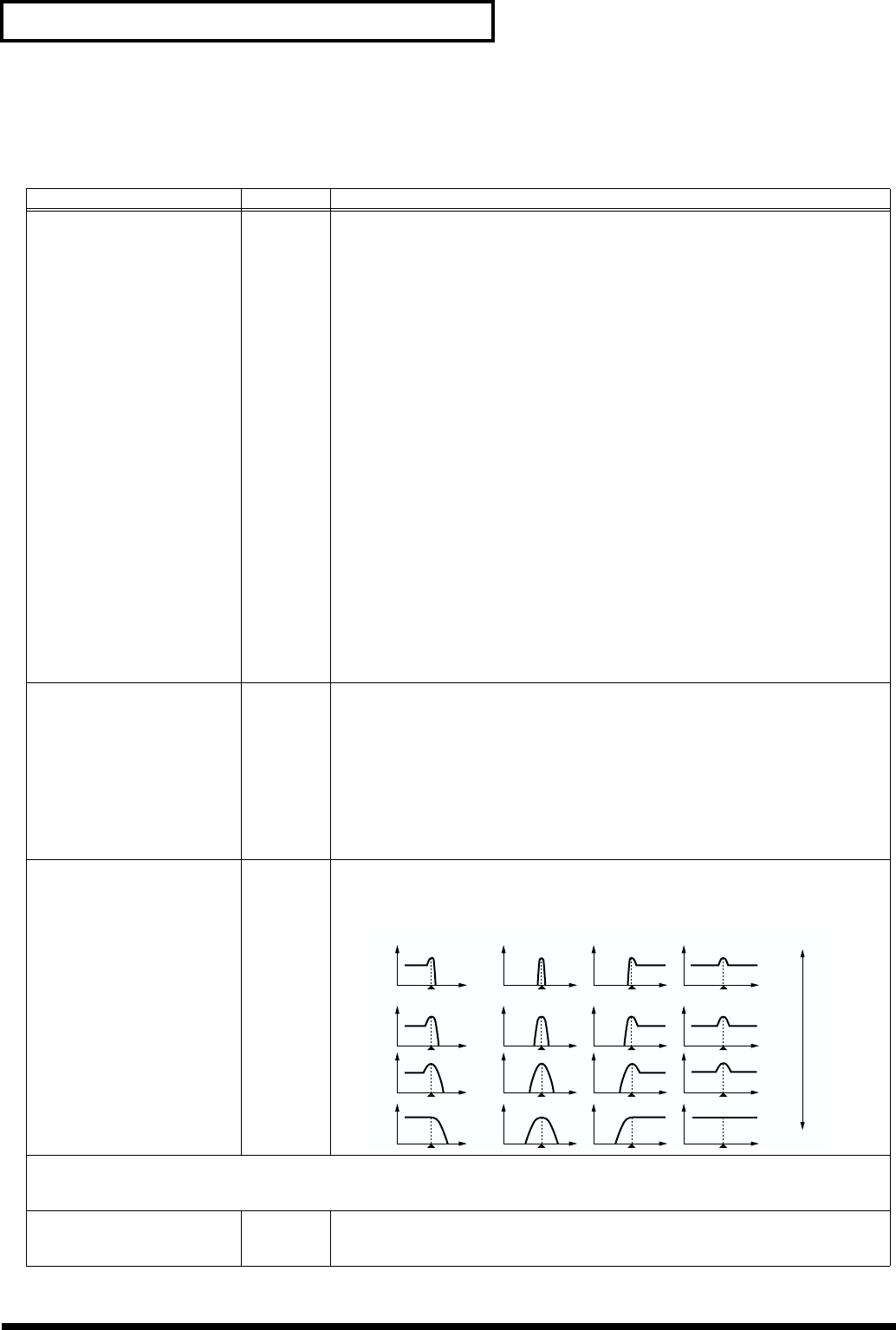
66
Creating a Rhythm Set
RHYTHM KEY TVF (Modifying the Brightness of a Sound with a Filter)
The settings for the TVF (Time Variant Filter) allow you to change a Rhythm Tone’s timbral content by
altering its brightness or thickness.
Parameter Value Description
FILTER TYPE
(Filter type)
OFF, LPF,
BPF, HPF,
PKG,
LPF2,
LPF3
This selects a filter type. A filter typically reduces, or attenuates, a specific frequency
range within a Tone in order to accentuate its other frequencies.
OFF: No filter is used.
LPF: A Low Pass Filter reduces the volume of frequencies above the cutoff frequency
in order to round off, or un-brighten, the sound. This is the most common filter used
in synthesizers.
BPF: A Band Pass Filter reduces the volume of frequencies below and above the cutoff
frequency range. This is most effective when creating sounds with strong characteris-
tics since it can accentuate a desired range of frequencies anywhere in the sound.
HPF: A High Pass Filter reduces the volume of the frequencies below the cutoff fre-
quency. This is suitable for creating percussive sounds by rolling of their lower fre-
quencies, thus emphasizing their higher ones.
PKG: A Peaking Filter emphasizes frequencies around the cutoff frequency by raising
their level. You can use this to create wah-wah effects by employing an LFO to change
the cutoff frequency cyclically.
LPF2: Low Pass Filter 2. This reduces the volume of all frequencies above the cutoff
frequency. This differs from LPF in that you can control the amount of the reduction
using the TVF ENVELOPE settings while still maintaining a fixed cutoff frequency.
This can be very effective with acoustic-instrument-based Tones, since nothing is done
to weaken the power and energy of the sound.
* This disables the Resonance setting.
LPF3: Low Pass Filter 3 reduces the volume of frequencies above the cutoff frequency.
While similar to LPF2, it filter reduces the frequencies more gently than LPF2. This can
be very effective with acoustic-instrument-based Tones, since nothing is done to weak-
en the power and energy of the sound.
* This disables the Resonance setting.
CUTOFF
(Cutoff frequency)
0–127 This selects the frequency at which the filter begins to have an effect on the waveform’s
frequency components. With LPF/LPF2/LPF3 selected for the Filter Type parameter,
lower cutoff frequency settings reduce a Rhythm Tone’s upper harmonics for a more
rounded, warmer sound. Higher settings make it sound brighter.
When Filter Type is BPF, the cutoff frequency setting determines the range of frequencies
within the Rhythm Tone that will be heard. This can be useful when creating distinctive
sounds. When Filter Type is HPF, higher settings of the cutoff frequency decrease the lev-
el of the Rhythm Tone’s low frequencies, preserving its brighter qualities. When Filter
Type is PKG, the cutoff frequency setting determines the range of frequencies to be em-
phasized.
RES
(Resonance)
0–127 This increases the level of the cutoff frequency to add a popular classic synth character
to the sound. Excessively high settings can produce oscillation, causing the sound to dis-
tort.
TVF VELOCITY
This sets the amount of change to the original cutoff frequency in response to differences in velocity, as well as the velocity response curve
and velocity’s effect on Resonance.
RES VEL SENS
(TVF resonance velocity
sensitivity)
-63–+63 Use this parameter when you want velocity to affect the amount of Resonance. With
higher settings, there is a greater difference in the amount of Resonance between softly
and strongly played notes. Negative (-) values reverse the direction of the change.
LPF BPF HPF PKG
parameter value
Level
Cutoff frequency
Frequency
High
Low


















